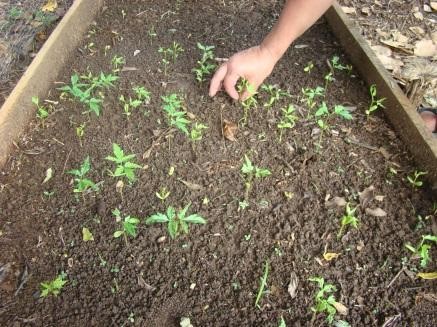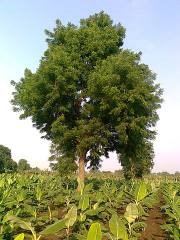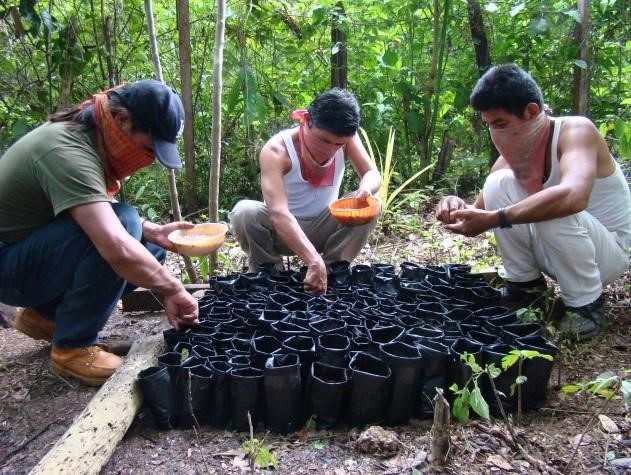Neem
 Common Name: Nim, neem, nimtree, indian lilac
Common Name: Nim, neem, nimtree, indian lilac
Scientific Name: Azadirachta indica A.
Climate: Hot
Plant Description: The Neem is a robust, evergreen tree with a thick bark and a round crown. This tree can reach a height of up to 20 meters in its adult stage, and the crown can measure up to 10 meters with a diameter. It achieves its maximum fruit production at 10 years, which is approximately 50 kg per tree per year. Can live more than 150 years. The leaves are even, pinnate, 20-30 cm long and have medium to dark green leaflets. The terminal leaf is often missing. The flowers are white, cream or yellowish, fragrant, and grow on spikes of falling axillary flowers. The fruits are olive-shaped, ranging in shape from elongated to almost rounded, measuring 1.4-2.8 x 1.0-1.5 cm. They are green when young and yellowish green to yellow when ripe. The skin of the fruit is thin and the pulp is bittersweet. The hard, white shell of the seed has 1 to 3 elongated seeds.
 Cultivation: The neem tree grows well in a wide range of soils. Neem can grow even on rocky soils where water availability is a major problem. But the best soils for its growth are those that have good drainage, deep, with a sandy-loam or clay-loam texture.1
Cultivation: The neem tree grows well in a wide range of soils. Neem can grow even on rocky soils where water availability is a major problem. But the best soils for its growth are those that have good drainage, deep, with a sandy-loam or clay-loam texture.1
It can reproduce by seed or cuttings.
If the seeds are sown in a seedbed they will germinate approximately one month after the fruit falls from the tree. The fruit is removed from the seed and the seed is allowed to harden for several days in the shade before planting. The seed is sown in a seedbed at 10 cm distance between each other. When the small trees reach 10 cm tall (usually 4-6 weeks), carefully transplant them into deep containers. It is because the main root grows 2 to 3 times deeper than the height of the tree.  When a tree has several lateral branches and reaches 30 cm in height (between 8 and 12 weeks), it can be planted directly in the ground in place with a direct sun. During the first year, it should be protected from ants, herbs, and watered regularly.
When a tree has several lateral branches and reaches 30 cm in height (between 8 and 12 weeks), it can be planted directly in the ground in place with a direct sun. During the first year, it should be protected from ants, herbs, and watered regularly.
Planting cuttings. Neem cuttings take root easily if kept in a warm, humid environment in non-direct sunlight. Cuttings should be 10 to 15 cm long and the diameter of a pencil. Remove all but the top two leaves from each cut, and cut these two leaves in half to minimize moisture loss while the cut is forming roots. Stick the bottom half of the cut into a growth soil and wait several weeks for the roots to begin to grow. Keep rooted cuttings in partial shade until they are one or two months old. Slowly expose to full sun and wait to plant in permanent place until the trees are at least 90 cm tall, usually after a year of growth.
Watering should be frequent but light. Neem is considered a drought resistant plant, since it has a single main root that grows very deep downwards and does it very quickly. It is necessary to do two to three weeds during the first year and one weed during the second year. Fertilize the tree once a month during spring and summer.
Neem leaves can be harvested at any time of the year. It is recommended to do the leaf harvest in the morning. Neem trees grow rapidly and begin to produce fruit from the third or fifth year.
 Uses: Leaves, fruit, seeds and bark of this tree are used to make medicines to treat diseases like diabetes, intestinal worms, liver problems, malaria, skin problems, cleaning blood, caries. Also to treat diseases of the heart and blood vessels, as well as respiratory problems.
Uses: Leaves, fruit, seeds and bark of this tree are used to make medicines to treat diseases like diabetes, intestinal worms, liver problems, malaria, skin problems, cleaning blood, caries. Also to treat diseases of the heart and blood vessels, as well as respiratory problems.
It is used to make various insecticides in agriculture. The spray made from its leaf is being used to remove ticks from livestock or to avoid pests on the grains. The flowers of this tree attract and feed the bees, and the tree itself repels mosquitoes. Neem wood makes excellent firewood and charcoal.
Neem improves the soil and many farmers put Neem trees around their fields and between the rows of beans and corn.
Pests and Diseases: Pulvinaris maxima is the main pest of the neem. Tip borer; Tea mosquito; Rhizoctonia leaf blight, leaf spot, and blight affect young seedlings and plants.2
References:
- http://www.campopotosino.gob.mx/modulos/Docs-descargar/FOLL.%20TEC.%20003.pdf
- http://agritech.tnau.ac.in/banking/PDF/Forestry%20Wasteland_Neem.pdf
En español: Nim
